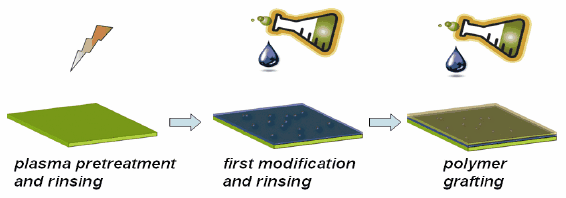Procedure for Standard Surface Modification using the Aldrich® Kit for Creating Hydrophilic PDMS Surfaces
Product Description
Use of this kit results in a durable hydrophilic PDMS surface. The resulting surface should be wettable by hydrophilic inks and appropriate for multiple printing applications. After treatment, water should completely wet the surface as the water contact angle is expected to be between 25 and 35 °.
Components
Solution A - 10 mL
(Glycidyl methacrylate based polymer)
Solution B - 4 mL
(Acrylamide/acrylic acid based polymer)
Solvents recommended, but not provided
- Ethanol (Catalog Number 245119)
- 2-Butanone (Catalog Number 230294)
- Water (Catalog Number 320072)
Precautions and Disclaimer
This product is for R&D use only, not for drug, household, or other uses. Please consult the Safety Data Sheet for information regarding hazards and safe handling practices.
Storage/Stability
Store the kit at room temperature.
Procedure
Procedure for standard surface modification

- Pretreatment - PDMS surface should be activated using a low frequency air plasma treatment for 1 minute (Recommended plasma cleaners: Catalog Numbers Z561673, Z561681, Z561657, and Z561665).
- Prerinsing - The plasma activated PDMS sample should be rinsed by washing with ethanol (Catalog Number 245119) for at least 10 minutes. The rinsing procedure should be repeated 3 times. Then, the sample should be air-dried for at least 15 minutes. The water contact angle of the resulting activated PDMS surface is expected to be between 25 and 40 °C.
- First Modification Step - The surface of the horizontally positioned sample prepared in the previous step should be covered with Solution A, typically ~1 mL per square inch of the surface. The sample should be dried under ambient conditions for 20–30 minutes and annealed at 110 °C under nitrogen or argon for 30 minutes.
- Rinsing - The annealed sample should be rinsed three times with 2-Butanone (Catalog Number 230294) for 10 minutes each time. Then it should be air-dried for at least 30 minutes.
- Polymer Grafting - 6 mL of ethanol must be added to the container containing Solution B. Stir the mixture to homogeneity. The surface of the horizontally positioned sample prepared previously should be treated by completely covering the area to be modified with the homogeneous solution, typically ~1 mL per square inch of the surface. The sample should be dried under ambient conditions for 20–30 minutes, then annealed at 80 °C for 14 hours. Finally, the unattached polymer should be removed from the sample by a thorough rinse with water (Catalog Number 320072) and the sample air-dried at room temperature.
Materials
Loading
Sign In To Continue
To continue reading please sign in or create an account.
Don't Have An Account?